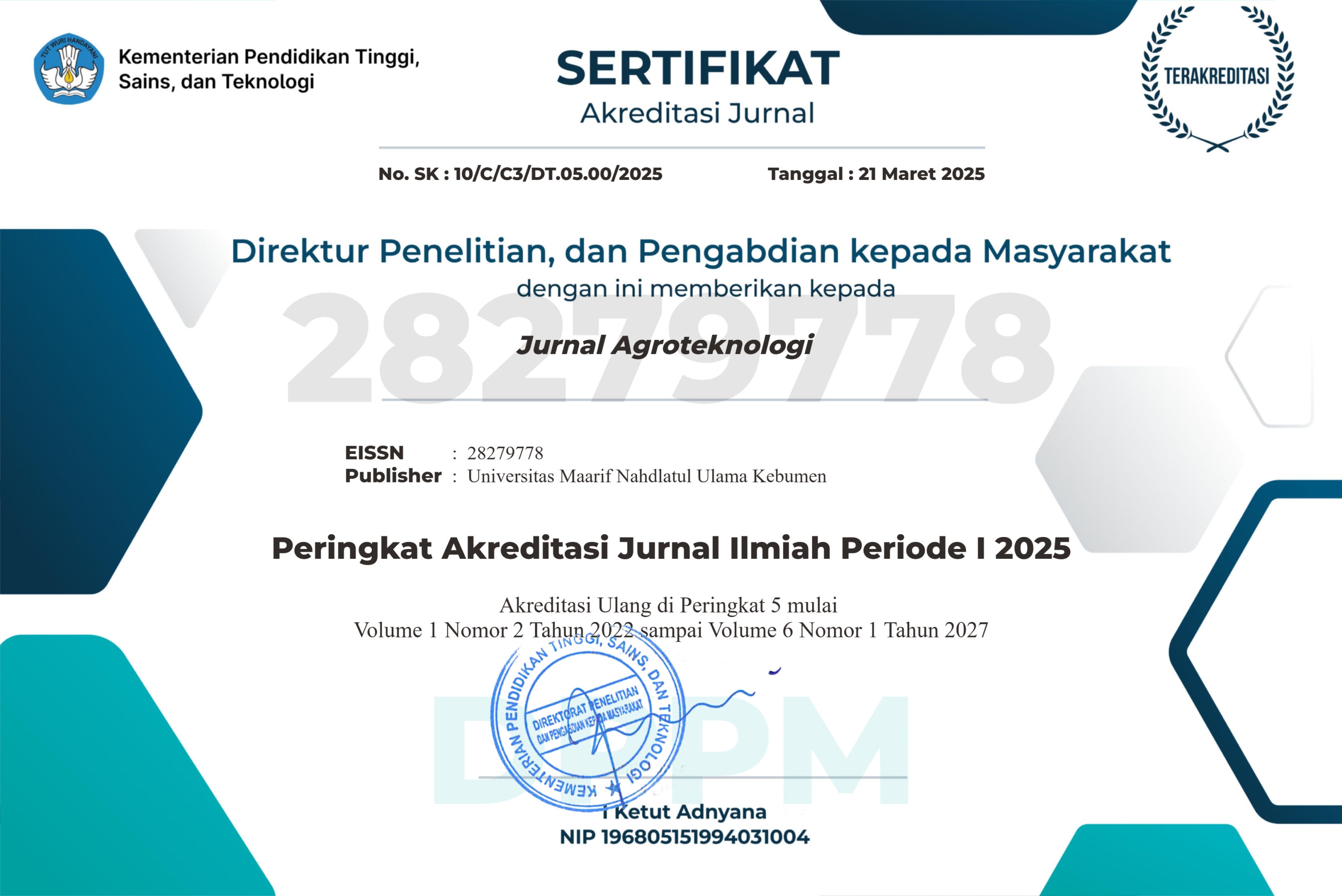Komunitas Gulma pada Sistem Tumpangsari Jagung Manis dengan Lima Jenis Kacang
DOI:
https://doi.org/10.53863/agronu.v4i02.1748Keywords:
Sweet corn, polyculture, legumes, and diversity of weeds.Abstract
Sweet corn (Zea mays saccharata Sturt) is usually grown in monoculture with wide spacing, which stimulates the growth of weeds around the maize. Weed management is mostly carried by chemicals, which could have a negative environmental impact. One technique to reduce this negative impact is the intercropping system. This study aimed to determine the diversity of weeds and the effectiveness of legumes in suppressing weed growth in intercropping systems. The experiment was designed as a single factor randomized complete block design (RCBD) with three replications. The treatment consisted of five types of legumes: groundnut, soybean, kidney bean, cowpea, and mungbean. The control consisted of a monoculture of sweet corn and legumes. The results showed that 33 types of weeds were present in the intercropping system, with the dominant species being Cyperus rotundus, Cynodon dactylon, Physalis angulata, and Phyllanthus niruri. Intercropping with all species of legumes and sweet corn can suppress weed growth without reducing sweet corn yield. Intercropping sweet corn and cowpea had the highest ability to suppress weeds
References
Adegaye, A. C., Fabunmi, B. T., Ogunjo, S. T., Tokimi, O. R., & Nwakaeme, J. O. (2023). Effects of two commonly used herbicides on soil microbial activity under conservation tillage. Environmental Advances, 13, 100424. https://doi.org/10.1016/J.ENVADV.2023.100424
Agus, N. S., & Sarjiyah. (2021). Keanekaragaman dan Kelimpahan Gulma pada Tumpangsari Jagung Manis dan Kacangan. Bioeksperimen, 7(2), 143–153.
Ali, A., Ahmed, S., Laghari, G. M., Laghari, A. H., Soomro, A. A., & Jabeen, N. (2024). Effect of Maize (Zea mays) and Soybean (Glycine max) Cropping Systems on Weed Infestation and Resource Use Efficiency. Agronomy, 14(12). https://doi.org/10.3390/agronomy14122801
Asih, D. S. N., Agus, N. S., & Sarjiyah. (2018). Weed Growth in Various Population of Corn-Peanut Intercropping. Plant Tropica Jurnal Agrosin, 6(1), 22–23.
Baranowska, A. (2023). The Nutritional Value and Health Benefits of Sweet Corn Kernels (Zea Mays Ssp. Saccharata). Health Problems of Civilization, 17(4), 408–416. https://doi.org/10.5114/hpc.2023.133364
BPS (Badan Pusat Statistik). (2025). Luas Panen, Produksi, dan Produktivitas Jagung Menurut Provinsi, 2024. https://www.bps.go.id/id/statistics-table/2/MjIwNCMy/luas-panen--produksi--dan-produktivitas-jagung-menurut-provinsi.html
Chipomho, J., Rugare, J. T., Mabasa, S., Zingore, S., Mashingaidze, A. B., & Chikowo, R. (2020). Short-term impacts of soil nutrient management on maize (Zea mays L.) productivity and weed dynamics along a toposequence in Eastern Zimbabwe. Heliyon, 6(10), e05223. https://doi.org/10.1016/j.heliyon.2020.e05223
Da Silva, A. C. M., Bezerra, J. J. L., Prata, A. P. D. N., De Souza, R. C., & Paulino, C. L. de A. (2020). Phytochemical Profile and Evaluation of the Allopathic Effect of Three Species of the Genus Cyperus (Cyperaceae). Journal of Agricultural Studies, 8(3). https://doi.org/10.5296/jas.v8i3.16724
Dwi, N. S. A. (2017). Pertumbuhan Gulma Pada Berbagai Proporsi Populasi Jagung Manis+Kacang Tanah Pola Tumpangsari. University Muhammadiyah of Yogyakarta.
Henry, G. M., Elmore, M. T., & Gannon, T. W. (2021). Cyperus esculentus and Cyperus rotundus. Biology and Management of Problematic Crop Weed Species, 1st Edition, 151–172. https://doi.org/10.1016/B978-0-12-822917-0.00011-2
Jumatang, E. T., & Masniawati, A. (2020). Identifikasi Gulma di Lahan Tanaman Talas Jepang Colocasia esculenta L. Schott Var. Antiquorum di Desa Congko Kecamatan Marioriwawo Kabupaten Soppeng. Jurnal Biologi Makasar, 5(1), 69–78.
Kantikowati, E., Karya, & Iqfini, H. K. (2022). ertumbuhan dan Hasil Jagung Manis (Zea maysL. Saccharata Sturt.) Varietas Paragon Akibat Perlakuan Jarak Tanam dan Jumlah Benih. Jurnal Ilmiah Pertanian Agro, 4(2), 1–10.
Machleb, J., Peteinatos, G. G., Kollenda, B. L., Andújar, D., & Gerhards, R. (2020). Sensor-based mechanical weed control: Present state and prospects. Computers and Electronics in Agriculture, 176, 105638. https://doi.org/10.1016/J.COMPAG.2020.105638
Mangoensoekarjo, S., & Soejono, A. T. (2015). Ilmu Gulma dan Pengelolaan Pada Budidaya Perkebunan. Gadjah Mada University Press.
Namatsheve, T., Cardinael, R., Chikowo, R., Corbeels, M., Rugare, J. T., Mabasa, S., & Ripoche, A. (2024). Do intercropping and mineral nitrogen fertilizer affect weed community structures in low-input maize-based cropping systems? Crop Protection, 176, 106486. https://doi.org/10.1016/J.CROPRO.2023.106486
Ngawit, I. K., Farida, N., Wayan, N., Suliartini, S., & Halumah, F. (2025). Diversitas , Populsi , dan Pertumbuhan Gulma pada Sistem Pola Tanam Tumpangsari Antara Jagung dengan Tanaman Kacang-kacangan di Lahan Kering Diversity , Population , and Weed Growth in The Intercropping System Between Maize and Legumes in Dry Land. 4(1), 234–246.
Ngawit, I. K., Sudika, I. W., & Suana, I. W. (2024). Weed Biology and Ecology Studies: Diversity, Dominance, Population and Weed Growth and Land Use Efficiency in Intercropping Corn (Zea mays l.) with Leguminous Crops in Dryland. Jurnal Penelitian Pendidikan IPA, 10(6), 3193–3204. https://doi.org/10.29303/jppipa.v10i6.7230
Paiman, Ardiyanta, Tri Kusumastuti, C., Kusberyunadi, M., & Bahrum, A. (2019). Nutgrass Response to Drought Stress on Different Soil Types. Vegetalika, 8(2), 125–138.
Putra, E. P., Yudono, P., & Waluyo, D. S. (2018). Perubahan Komposisi Gulma pada Sistem Tumpangsari Padi Gogo dengan Kedelai di Lahan Pasir Pantai. Jurnal Agronomi Indonesia, 46(1), 33–44.
Ro, S., Roeurn, S., Sroy, C., & Prasad, P. V. V. (2023). Agronomic and Yield Performance of Maize-Mungbean Intercropping with Different Mungbean Seed Rates under Loamy Sand Soils of Cambodia. Agronomy, 13(5). https://doi.org/10.3390/agronomy13051293
Sari, L. A. (2023). Komunitas Gulma Dalam Sistem Tumpangsari Jagung dan Kacang Tunggak. Jurnal Agrosasepa, 1(2).
Schwartz-Lazaro, L. M., & Copes, J. T. (2019). A review of the soil seedbank from a weed scientists perspective. Agronomy, 9(7), 1–13. https://doi.org/10.3390/agronomy9070369
Sharma, N., & Rayamajhi, M. (2022). Different Aspects of Weed Management in Maize (Zea mays L.): A Brief ReviewNo Title. Advances in Agriculture, 7960175. https://doi.org/https://doi.org/10.1155/2022/7960175
Trognitz, F., Hackl, E., Widhalm, S., & Sessitsch, A. (2016). The role of plant-microbiome interactions in weed establishment and control. FEMS Microbiology Ecology, 92(10), 1–15. https://doi.org/10.1093/femsec/fiw138
Downloads
Published
How to Cite
Issue
Section
License
Copyright (c) 2025 Sri Devi Octavia, Andre Setiyawan

This work is licensed under a Creative Commons Attribution-ShareAlike 4.0 International License.
Authors retain copyright and grant the journal right of first publication with the work simultaneously licensed under a Creative Commons Attribution-ShareAlike 4.0 International License that allows others to share the work with an acknowledgment of the work’s authorship and initial publication in this journal











